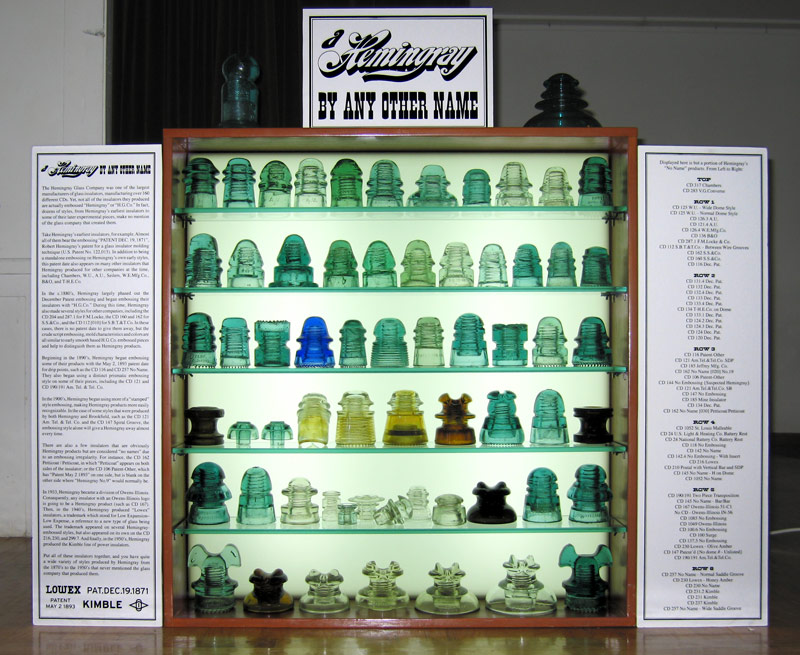

This was my first specialty display. Instead of display general Hemingray insulators, I focused on just Hemingray insulators that weren't actually embossed with "Hemingray" on them. To an unseasoned collector, some of these pieces might not seem to be Hemingray pieces. My display was the only one scheduled aside from the club's combined display, although Richard Dawson brought along a great display, so no awards were given out. I ended up re-using this idea under a different name, "Undercover Hemingrays" at the 2012 Kansas City National, and by that point I had added a lot more of these unnamed Hemingrays to my collection!


The Hemingray Glass Company was one of the largest manufacturers of glass insulators, manufacturing over 160 different CDs. Yet, not all of the insulators they produced are actually embossed "Hemingray" or "H.G.Co." In fact, dozens of styles, from Hemingray’s earliest insulators to some of their later experimental pieces, make no mention of the glass company that created them.
Take Hemingray’s earliest insulators, for example. Almost all of them bear the embossing "PATENT DEC. 19, 1871", Robert Hemingray’s patent for a glass insulator molding technique (U.S. Patent No. 122,015). In addition to being a standalone embossing on Hemingray’s own early styles, this patent date also appears on many other insulators that Hemingray produced for other companies at the time, including Chambers, W.U., A.U., Seilers, W.E.Mfg.Co., B&O, and T-H.E.Co.
In the c.1880’s, Hemingray largely phased out the December Patent embossing and began embossing their insulators with "H.G.Co." During this time, Hemingray also made several styles for other companies, including the CD 204 and 287.1 for F.M.Locke, the CD 160 and 162 for S.S.&Co., and the CD 112 [010] for S.B.T.&T.Co. In these cases, there is no patent date to give them away, but the crude script embossing, mold characteristics and colors are all similar to early smooth based H.G.Co. embossed pieces and help to distinguish them as Hemingray products.
Beginning in the 1890's, Hemingray began embossing some of their products with the May 2, 1893 patent date for drip points, such as the CD 116 and CD 257 No Name. They also began using a distinct prismatic embossing style on some of their pieces, including the CD 121 and CD 190/191 Am. Tel. & Tel. Co.
In the 1900's, Hemingray began using more of a "stamped" style embossing, making Hemingray products more easily recognizable. In the case of some styles that were produced by both Hemingray and Brookfield, such as the CD 121 Am. Tel. & Tel. Co. and the CD 147 Spiral Groove, the embossing style alone will give a Hemingray away almost every time.
There are also a few insulators that are obviously Hemingray products but are considered "no names" due to an embossing irregularity. For instance, the CD 162 Petticoat / Petticoat, in which "Petticoat" appears on both sides of the insulator; or the CD 106 Patent-Other, which has "Patent May 2 1893" on one side, but is blank on the other side where "Hemingray No.9" would normally be.
In 1933, Hemingray became a division of Owens-Illinois. Consequently, any insulator with an Owens-Illinois logo is going to be a Hemingray product (such as CD 167). Then, in the 1940's, Hemingray produced "Lowex" insulators, a trademark which stood for Low Expansion–Low Expense, a reference to a new type of glass being used. The trademark appeared on several Hemingray-embossed styles, but also appeared on its own on the CD 216, 230, and 299.7. And finally, in the 1950’s, Hemingray produced the Kimble line of power insulators.
Put all of these insulators together, and you have quite a wide variety of styles produced by Hemingray from the 1870's to the 1950's that never mentioned the glass company that produced them.